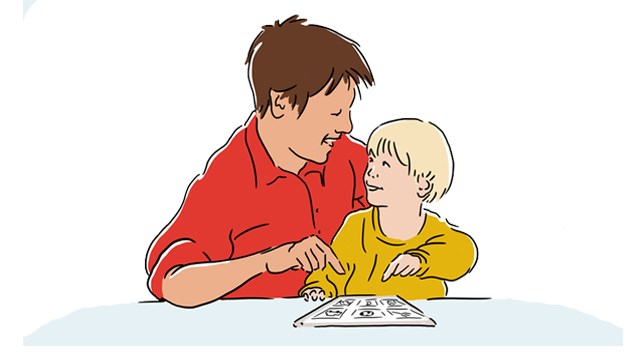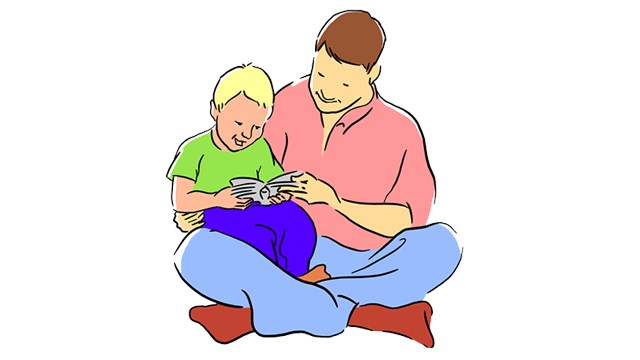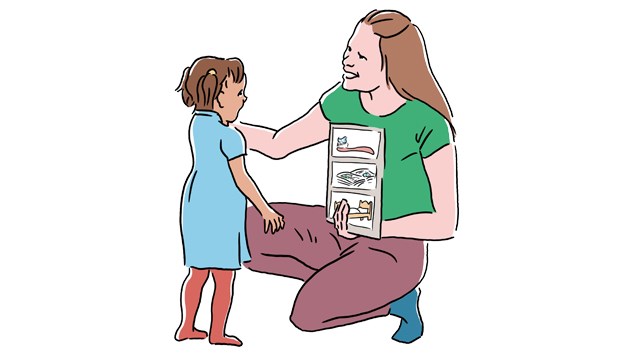Den här webbplatsen använder cookies, som samlar information om hur du interagerar med sidan. I kombination med de uppgifter du uppger, skapar vi en profil så att vi ska kunna visa relevant innehåll just för dig. Genom att acceptera tillåter du att vi samlar och behandlar dina personuppgifter enligt beskrivningen.
Get started playing
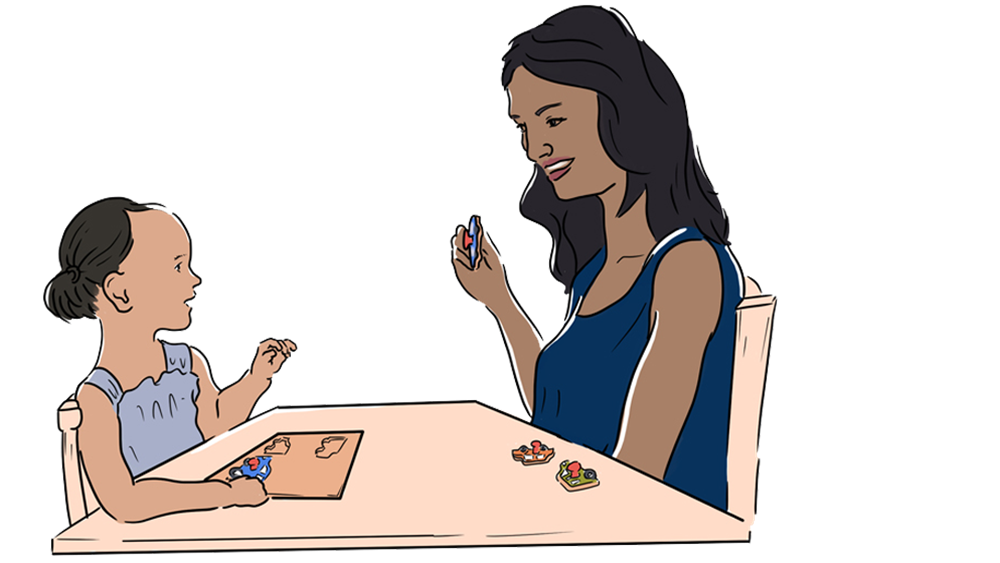
Why is it important?
Playing games is the natural way for young children to learn new things. It is through playing with others that children learn to communicate, solve problems and develop their imagination. Children today are spending more and more time in front of various screens. This means that they have fewer opportunities to play than they actually need. The World Health Organization (WHO) has therefore issued guidelines that children under the age of two should not spend any time at all in front of screens. As an adult, there is a lot you can do to help children make a start on playing and interacting at an early age.
How can I help my child?
As young children often find it hard to come up with and develop games on their own, adults sometimes have to help them with this. As an adult, you can plan for a playtime every day, where you and your child play and have fun together. You can also invite yourself to join in whatever your child is playing at an appropriate moment. You can then help develop the child’s game by bringing in a new toy or adding a new action. Here are some hints for how you can help your child get started playing.
Choose a good game
For young children, it is best to choose simple games that you can play over and over again. Choose a game where both you and the child have clear roles. This will make it easier for you to play together rather than playing separately. When doing picture puzzles together, you can put your child in charge of the board while you are in charge of the pieces. Your role is then to hand the pieces to the child, while his/her role is to put the pieces in the correct spaces in the board.
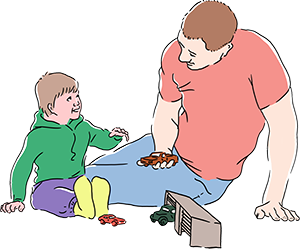
Try to find a game that you think your child will enjoy. If your child is particularly keen on cars, try to find a game involving toy cars. If your child likes moving about, think up some running and jumping games you can play outside. The most important thing when you are playing together is that you should always have fun so that you want to carry on playing games and doing other things together. When playing with toy cars, for example, you can hold all the cars and then pass them to your child to park in the garage.
Get ready for the playtime
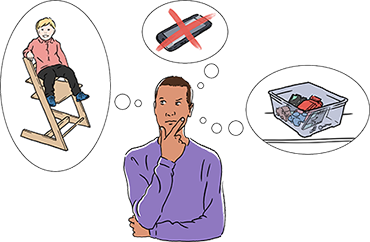
To make sure you have an enjoyable playtime together, it can be helpful to get everything ready in advance. Remove any objects that you will not be using in the game and which might distract you. Switch off the TV and put your smartphone away. Choose a place that is suitable for the game. One good idea is to put the materials for your games in a box or a bag that you can easily take out when you want to play with your child.
When planning to play a game with your child, it is important to make it clear to your child what you are thinking of playing. One good way to do this is to show your child a “game card” – a card with a picture of the game you want to play. Instructions are printed on the reverse side of the card to make sure that all adults know how to play the game. If you show your child the card before you start playing, he/she will quickly learn what game cards mean. Later on, your child can use game cards to choose different games or can ask to play a game by giving you the relevant game card.
You can see suggestions for games and what game cards can look like under the header “What can I play with my child?”
Teach your child the game
Young children learn through imitation – by looking at what others are doing and then trying to copy them. To teach a child the game, the adult must clearly show the child what to do. Children need to play games many, many times to learn them. Some actions are difficult for children to master, and they will need help from an adult the first few times. If you are doing a jigsaw puzzle with your child, for example, you can help him/her by pointing to where the different pieces go. It is important for children to experience success if they are to think playing games is fun and want to carry on playing.

Communication boards can help adults to teach children new games or develop existing ones. Game cards have pictures on them which can give you and your child suggestions for what you can do and say during the game. Under the header “What can I play with my child?” you will find suggestions for what game cards can look like, as well as videos showing how to use game cards.
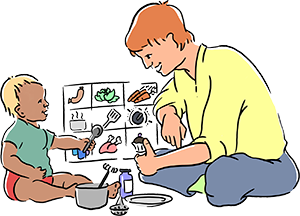
Capture and retain your child’s attention
Young children are easily distracted and lose focus. To play games together, it is therefore essential for the adult to capture and retain the child’s attention. One good way to do this is to use a lot of gestures, facial expressions and noises to capture your child’s attention. Don’t be afraid to exaggerate!
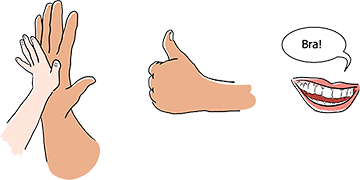
To retain the child’s attention, the adult may need to adapt the pace of the game. You sometimes have to take your time to help your child get going. Other times, you may have to be quick to make sure your child does not lose focus.
Building anticipation in the game is another way to capture your child’s attention. One simple way to do this is to count to three before something fun happens – for example, before you let your child slide down the slide, or before you lift him/her high up in the air. You can also pause a game to create a sense of excitement. If you are pushing your child on a swing, you can catch the swing and then give it a good push when your child looks expectantly at you.
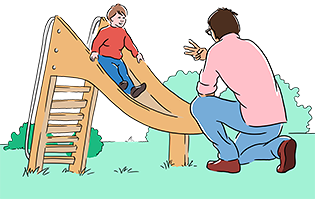
Have fun when you play
The most important thing when playing games with your child is to have fun together. Show your child that you think it is fun to do things together. It is also important to stop playing before your child becomes tired – better to play several short games than one long one. You can also film yourselves playing and then show your child the video afterwards. That way, your child can enjoy your fun game over and over again!
What can I play with my child?
Early games
The first games young children learn are often social games such as “peekaboo”, tickling, tag games or simply being lifted up. These are games you can play many times a day – on the changing table, for example, or while you’re waiting for the bus. When children are a little older, they often enjoy simple games like putting things in tins and taking them out again, or picking things up.
Easy games
Here are the five games shown in the video, as well as game cards for the games.
Five easy games - game cards (pdf för printing).
Games with rules
Games with rules are clear, simple games that are played the same way every time. As a result, a lot of children can quickly learn and participate in these games. Games with rules are fun to play with one child or a group of children.
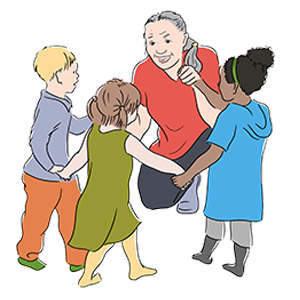
Here are suggestions for five games with rules.
Five games with rules – game cards (PDF for printing)
By using game cards, you clearly show the children what game you want to play. Game cards can also help children choose or ask for a specific game themselves.
Songs
Songs are fun, simple games that a lot of children love. It is a good idea to choose songs including clearly defined movements. This allows children to participate by doing the movements, even though they may not be able to sing along. If your child has learned to make noises or say some words, you can pause the song and let him/her fill in the gap.
Here are suggestions for five songs to begin with if you want to start singing together with your child.
Five songs – song cards (PDF for printing)
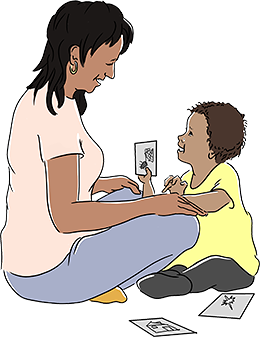
You can use the song cards to help prepare your child for the song you are going to sing. Later on, you can involve your child in choosing the song by letting him/her shuffle the cards.
Creative games
A lot of children love creative games that involve painting, drawing, stringing beads together and playing with Play-Doh. Adults need to show the children what to do with the material. Young children often like sequences that you can repeat over and over again. For example, you can roll out a “sausage” of Play-Doh, cut it into pieces, roll the pieces into small balls and place them in an empty chocolate box. In the same way as in all games, the most important thing is for you to have fun together.
Everyday routines
A lot of everyday activities provide perfect opportunities for playing games with young children. Children often have as much fun doing “real things” as they do playing with toys. Many everyday chores include actions that children enjoy, such as “put in and take out”, “give and take”, and sorting things.
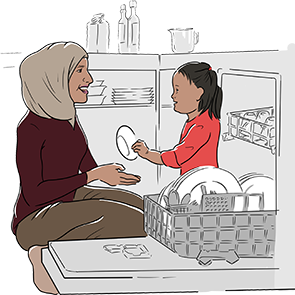
Let your child take part in activities such as laying the table, emptying the dishwasher, loading the washing machine, clearing away toys, wiping the table, taking out the trash and getting things for you.
Role play and fantasy games
When children are around two years old, the often start to play simple fantasy games such as feeding toy animals or playing with toy cars. As an adult, you can help your child to develop his/her games by adding in a new toy or coming up with a new action. If you are playing with toy cars, for example, you can draw parking spaces on a piece of board, or pretend you are going to the repair shop to have the cars fixed. If you are playing with toy animals and dolls, you can pretend that you are having a party for some of the dolls. It can sometimes be difficult to come up with something to play. A communication board can help both you and your child think up different things to do in the game. You can also use the pictures to help you communicate more during the game. As an adult, you must take care to be particularly clear about what you are saying and doing by pointing at the pictures. Your child can also point at the pictures to make comments and take the initiative himself/herself.
Here are five suggestions for how communication boards for different games can look:
- Play with toy cars – communication board (PDF for printing).
- Play with toy animals – communication board (PDF for printing).
- Play with action figures/dolls – communication board (PDF for printing).
- Playground – communication board (PDF for printing).
- Play with a ball – communication board (PDF for printing).
Play with toy animals
Play with toy cars
Why isn’t my child playing?
There may be several reasons why a child has not yet started playing:
- The child finds it difficult to pay attention to others. Children learn to play through imitation. They watch others are doing and then try to copy them. If the child finds it difficult to pay attention to what others are doing, he/she will also find it hard to imitate them and start playing.
- The child does not know what to do with the different toys or does not understand the game.
- The child has a short attention span and finds it hard to continue activities.
- The child is not motivated to try new things. Some children can “get stuck” in certain games or materials and find it hard to play with something they do not recognize or they cannot do.
If your child is having difficulty starting to play by himself/herself, it is particularly important that you, as the adult, help your child. If you are worried about your child’s development, contact your local child-care center (barnavårdscentral, BVC).
Printable summary of the page
Contact
This page has been created by the Health and Rehabilitation Division of Uppsala County. The information is intended for everyone looking for hints about how to encourage children to engage in play and communication.
To contact the person responsible for the content on the page, send an email to: habiliteringen@regionuppsala.se
